Basic AI Chatbot Pricing: A simple chatbot that can answer questions about a product or service might cost around $10,000 to develop.
Read More
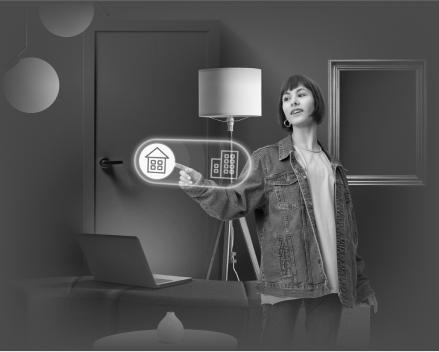
Ever thought about redesigning a living room without breaking a sweat (or a wall)?
It’s not a dream, it's the future!
The augmented reality (AR) market is booming, and it’s expected to hit a jaw-dropping $599 billion by 2030, while artificial intelligence (AI) is making its way into every corner of the real estate world, with the AI-driven market projected to soar from $2.9 billion in 2024 to $41.5 billion by 2033.
But here’s an important question for you:
Are you keeping up?
Or are you still sketching floorplans on napkins and imagining “what if” in your head?
Welcome to the era of smart renovations where augmented reality with AI in home renovation is more than just a cool tech trend. It’s a game-changer.
In this blog, we’ll dive into how AR and AI are reshaping the renovation game, making your business smarter, faster, and more efficient.
Stick around to learn how these tools can make your business not just survive but thrive in the ever-evolving world of home renovations.
When you think of home renovation, what comes to mind?
Dust?
Chaos?
Decisions that take way too long?
Well, AR just said, "Hold my virtual beer."
Augmented Reality (AR) is the magician’s wand for home design. It’s the ability to see potential changes in your home, in real-time, without picking up a single tool.
Imagine pointing your phone at an empty room and watching it transform into your dream space within seconds, no contractors needed.
Here’s how AR works its magic:
The real benefit? It cuts down on decision-making time and minimizes those “Oh no, I wish I chose something different” moments. AR makes the entire renovation process smoother, faster, and a whole lot more fun, especially when combined with expertise from a trusted UI/UX design company that ensures user-friendly experiences.
By now, you’re already getting the picture. AR isn’t just a tool, it’s a renovation companion, ready to turn your design ideas into real-time solutions.
Now, let’s talk about how AI takes this to a whole new level.
Also read: Top 15 UI/UX Design Companies in USA
Why imagine when you can preview your dream space in real time?
Talk to Our ExpertsIf AR is the magic wand, then AI is the brain behind the curtain, calculating, analyzing, and suggesting design choices that make you look like a home renovation genius.
While AR shows you how your space can look, AI in home renovation takes it a step further by making sure those choices are smart, functional, and cost-effective.
Here’s how AI plays a starring role in the renovation process:
AI enhances your home renovation by refining every decision, be it cost predictions, personalized design suggestions, or space optimization, and working with an experienced AI app development company ensures these solutions are implemented effectively.
Ready for the magic that happens when AR and AI team up?
Let’s get into how they work together to enhance everything.
Also read: Role of AI in Real Estate Development
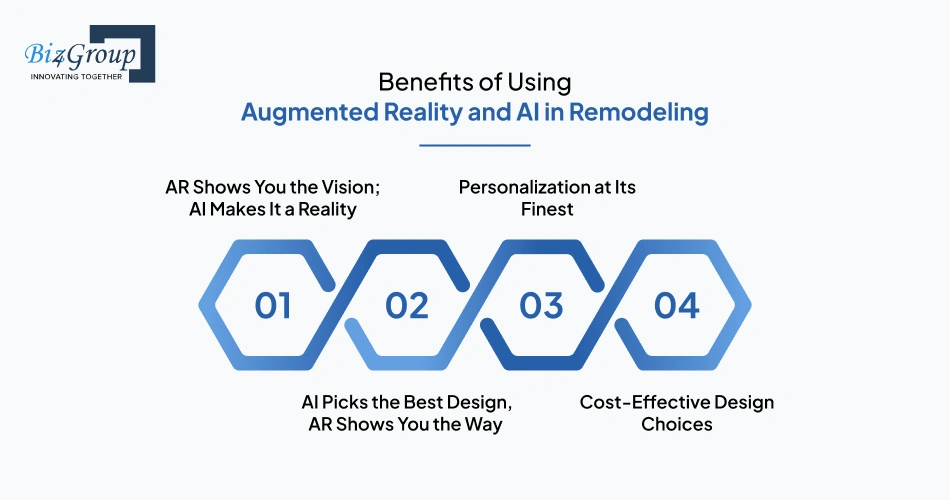
Imagine a world where your design ideas are brought to life instantly, with the brains to back them up.
That is what happens when you integrate augmented reality with AI in home renovation. It’s like having the best of both worlds: a real-time, virtual makeover, combined with intelligent, data-driven recommendations.
Here’s how AR and AI make the perfect home renovation team:
AR lets you see the future of your home, whether it’s a new couch, fresh paint, or a completely redesigned kitchen.
But here’s where AI steps in: it analyzes your space and suggests the smartest, most cost-effective options.
When you combine AR and AI, you create a seamless renovation process that’s as smart as it is visually stunning, helping clients make more confident decisions in less time.
Once AI has analyzed your room and given its recommendations, AR takes over to show you exactly how those changes will look in real-time.
Want to see how a bold, navy-blue wall looks with your existing furniture?
AR places it in front of your eyes, and AI ensures that it matches your style and maximizes space.
AR makes things look good, but AI makes things work for you.
By learning from your preferences and past design choices, AI suggests renovations tailored to your specific style and needs.
AR then brings those personalized ideas to life, giving you a real-time, interactive experience with your own home, without moving a single piece of furniture.
If you’ve ever gone over budget on a renovation, you know the pain. But with AI and AR, that doesn’t have to happen.
AI predicts costs for materials, labor, and design changes, ensuring you stay within budget, while AR shows you exactly what you’re getting before you commit, much like tailored AI product development services that balance innovation with practicality.
No more surprises, just smarter decisions.
In short, integrating AR with AI for home renovation doesn’t just save you time and money, it’s an experience that gives you full control over every aspect of your renovation, all in one seamless, interactive process.
Want to see how these two technologies can change your home design? Let’s dive into some practical applications.
Also read: AI and Augmented Reality: Transforming the Online Shopping Experience
Smarter design, fewer regrets, and cost savings are just a click away.
Contact NowIn today’s competitive home design market, staying ahead of the curve is essential. AR and AI are powerful tools that are reshaping the industry.
Here's why home renovation companies, real estate developers, and interior designers should consider investing in these technologies:
Client satisfaction is at the heart of every successful business. In a world where consumers expect personalization and immediacy, AR and AI provide exactly that.
Time is money in the renovation business, and minimizing errors is crucial to staying on budget and schedule.
In an industry where competition is fierce, staying ahead of the curve is critical. Embracing innovation will give your business the competitive edge it needs to stand out.
Operational efficiency directly impacts profitability. Reducing wasted time, improving resource allocation, and optimizing workflows are essential to running a successful business.
The future of home design is digital, and companies that don’t adapt risk being left behind. AR and AI are the keys to staying relevant in the ever-evolving design market.
Every business wants to deliver quality results on time and within budget. AR and AI are powerful tools for keeping projects on track.
Investing in AR and AI for home design is an absolute necessity for companies aiming to lead the way in an increasingly tech-driven market. These technologies enhance the customer experience, improve operational efficiency, and future-proof your business.
By adopting AR and AI, your company can not only meet today’s expectations but also position itself to thrive in tomorrow's marketplace.
Ready to see how to bring these technologies to life in your own business? Let's move on to the integration process and talk about how you can make it happen.
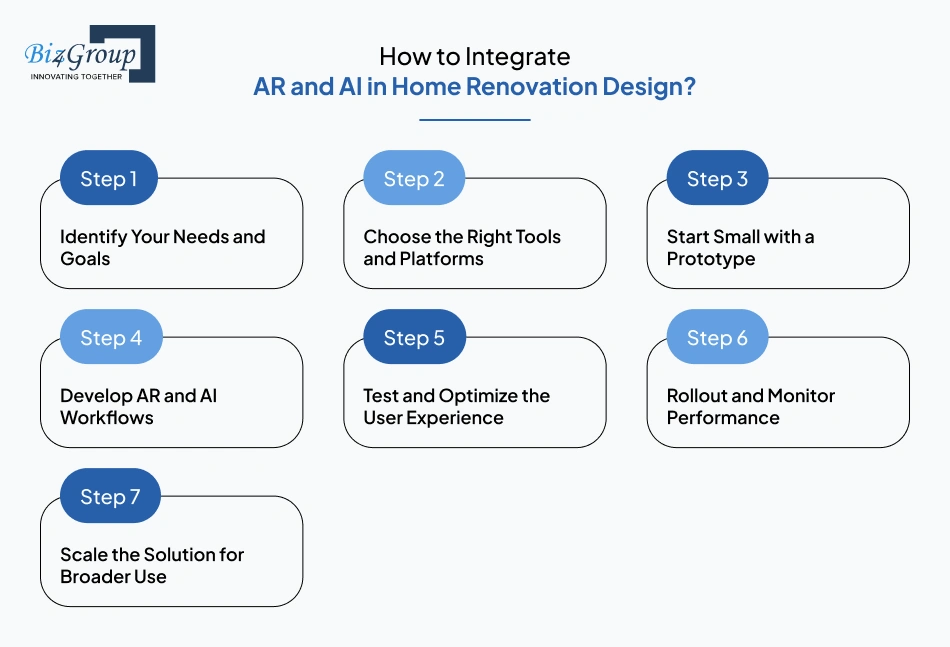
Now that we’ve explored how augmented reality with AI in home renovation can work wonders for businesses and clients alike, you’re probably wondering, “How do I actually integrate these technologies into my renovation process?” Let’s break it down step by step.
But before that, you should know, integrating AR and AI in home renovation isn’t an overnight thing, but a journey. One that can elevate your business and client satisfaction to new heights.
Here’s how to get started:
Before diving into the technical aspects, start by understanding what exactly you want to achieve with AR and AI.
Are you looking to enhance your design process? Improve client engagement? Optimize costs?
The clearer your goals, the better your integration process will be.
Key Considerations:
Once you know your goals, it’s time to choose the right tools to bring your vision to life.
The tech behind AR and AI integration for home renovation can vary, so selecting the right platforms is crucial, especially when developing scalable solutions with expert mobile application development practices.
Platforms like AWS, Microsoft Azure, and Google Cloud can be used for storage, real-time data processing, and the integration of machine learning algorithms with AR apps.
Don’t try to integrate everything at once. Start small and test out the integration with a prototype, ideally with the help of professional MVP development services that can validate your concept quickly, especially if you’re planning to build an AI real estate app MVP for the property sector.
This will help you work out any bugs and get feedback from your team or clients before scaling up.
Prototype Ideas:
Also read: Top 12+ MVP Development Companies in USA
AR and AI need to work together seamlessly, so it’s crucial to develop efficient workflows, something achievable through professional AI integration services that ensure smooth interoperability.
Here’s how to get both technologies to play nice:
AR for Visualization:
Use AR to project potential design changes onto the physical space, allowing clients to see, interact, and adjust in real-time.
AI for Data Processing:
AI analyzes design choices, predicts costs, and optimizes layouts based on space usage and client preferences. The results are then passed back to the AR app for instant visualization.
Example Workflow: A client picks a new sofa in the AR app.
Before rolling out the integration, make sure to test everything rigorously.
AR and AI are powerful tools, but the user experience needs to be seamless.
User Testing:
Once everything is set up and tested, it’s time to go live.
But the job doesn’t end there. Ongoing monitoring and optimization are key to ensuring long-term success.
Monitor KPIs:
Feedback Loop:
Once you’ve refined the integration for specific projects, consider expanding the scope to other areas of your business.
You can scale AR and AI integration to manage larger projects, offer additional services, or enhance client relationships.
Scaling Ideas:
Integrating AR and AI in home renovation can seem like a daunting task, but with the right approach, it can transform the way you do business.
From choosing the right tools and creating prototypes to testing and scaling, this technology integration isn’t just for big tech companies, it’s a game-changer for the home renovation industry.
By following these steps, you’ll be able to enhance your services, improve client satisfaction, and stay ahead of the competition in a tech-driven market.
We make AR + AI adoption as easy as choosing paint colors.
Schedule a Free CallWhen integrating augmented reality with AI in home renovation, it’s not just about delivering innovative and engaging solutions. It's also about protecting your clients' sensitive information.
Ensuring that your technologies adhere to security best practices and regulatory standards is crucial for maintaining trust and avoiding costly legal issues.
Here’s how security and compliance play an essential role in the integration of AR and AI in home renovation:
| Aspect | What It Means | Best Practices | Relevant Regulations |
|---|---|---|---|
|
Data Privacy |
Protecting user information such as preferences, financial data, and design choices. |
- Encrypt data at rest and in transit. |
- GDPR (General Data Protection Regulation) for EU. |
|
Secure Data Storage |
Ensuring client data is securely stored in cloud systems. |
- Use cloud services with SOC-2 and ISO 27001 certifications. |
- ISO 27001 (Information Security Management). |
|
AI Ethics and Transparency |
Ensuring AI algorithms are transparent, unbiased, and explainable. |
- Implement explainable AI (XAI) methods to make the AI's decisions understandable. |
- AI Ethics Guidelines (EU and global standards). |
|
Regulatory Compliance |
Complying with data protection laws that apply to home renovation technologies. |
- Familiarize with GDPR, CCPA, and other local regulations. |
- GDPR, CCPA, SOC-2, HIPAA (if handling health-related data). |
|
Data Breach Prevention |
Preventing unauthorized access or exposure of sensitive information. |
- Implement multi-layer security such as firewalls, anti-malware tools, and data loss prevention (DLP) systems. |
- SOC-2 for security practices. |
|
Cloud Security |
Ensuring the cloud platforms you use for storage and AI processes are secure. |
- Use cloud services with encrypted communications and access controls. |
- SOC-2, ISO 27001, NIST SP 800-53 (for US-based businesses). |
|
Client Transparency |
Keeping clients informed about how their data is used and protected. |
- Be transparent about data usage in your privacy policies. |
- GDPR, CCPA, PCI-DSS (for payment data). |
Clients are more likely to engage with businesses that prioritize their privacy and security. Being transparent about your security measures will not only enhance client trust but also position you as a responsible business in the competitive market.
Compliance with regulations such as GDPR and CCPA protects your business from heavy fines and legal risks, another reason why partnering with a reliable AI development company is crucial for building secure and compliant systems. If you’re using AI to analyze client data, ensuring ethical AI practices will prevent legal challenges related to bias or discrimination.
As AI becomes more prominent, ethical use is essential. Clients will want to know that the suggestions provided by AI are not only smart but fair and unbiased, especially when it comes to design and financial predictions, a principle equally important when learning how to build real estate AI software.
By following these guidelines, you can implement AR and AI in home renovation while safeguarding sensitive data, meeting legal requirements, and maintaining a strong reputation.
With security and compliance covered, your next step is to stay ahead of the curve by diving into some of the challenges you might face (and knowing how to overcome them.)
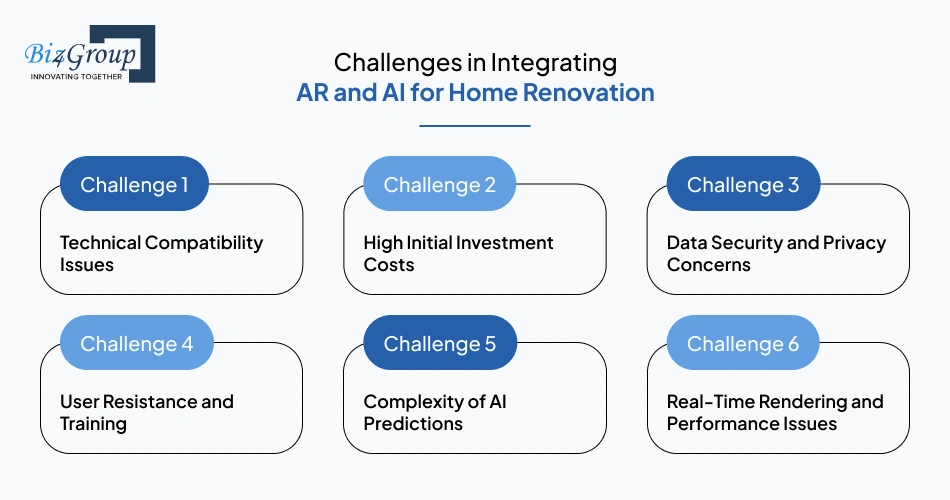
Integrating AR and AI in home renovation can seem like a futuristic dream, but like any tech, it comes with its own set of challenges.
However, every problem has a solution, and by addressing these challenges head-on, you can make your AR and AI integration smooth, effective, and successful.
Here are the most common hurdles you might encounter and how to tackle them:
The tools and technologies used in AR and AI are not always compatible with existing systems, which can lead to integration headaches.
Solution:
The cost of implementing AR and AI solutions can be prohibitive, especially for smaller companies.
Solution:
The data collected by AR and AI systems, such as client preferences, financial details, and design choices, may be sensitive and susceptible to breaches.
Solution:
Employees and clients might resist adopting AR and AI technologies due to unfamiliarity or fear of the unknown.
Solution:
AI algorithms can sometimes make inaccurate predictions, especially when analyzing complex data like interior designs or renovation costs.
Solution:
AR systems can sometimes struggle with real-time rendering, especially in large or complex spaces, leading to lag or poor performance.
Solution:
To ensure a smooth and successful AR and AI integration for home renovation, it's important to follow best practices and avoid common mistakes. Here’s a breakdown:
| Mistake | Why It’s a Problem | Best Practices |
|---|---|---|
|
Overcomplicating the Integration |
Trying to do too much at once can overwhelm both your team and your clients. |
- Start small with a focused use case (e.g., AR for design visualization). |
|
Ignoring Data Privacy |
Failing to secure client data can lead to security breaches and legal issues. |
- Implement strong encryption and comply with data privacy laws (e.g., GDPR, CCPA). |
|
Neglecting User Feedback |
Without user feedback, you can miss out on improvements that will enhance the user experience. |
- Regularly collect feedback from clients and employees and use it to refine your systems. |
|
Underestimating the Learning Curve |
Assuming that clients or staff will quickly adapt to new technologies can lead to frustration. |
- Provide training and easy-to-understand resources to help users get comfortable with AR/AI tools. |
|
Choosing Incompatible Tools |
Using AR or AI tools that don’t work well together can lead to poor performance and frustration. |
- Select tools and platforms that are compatible with each other and your current systems. |
By identifying potential challenges early and applying the right solutions, your AR and AI integration can be smooth and successful.
Following best practices ensures that you’re not only implementing cutting-edge technologies but doing so in a way that maximizes efficiency and client satisfaction.
Next, let’s look at the future trends in AR and AI for Home Renovation. These trends will help you stay ahead of the curve and maintain a competitive edge in a rapidly evolving market.
Also read: Augmented Reality Development and Its Challenges
From data privacy to seamless workflows, we handle the tough stuff.
Build with Biz4Group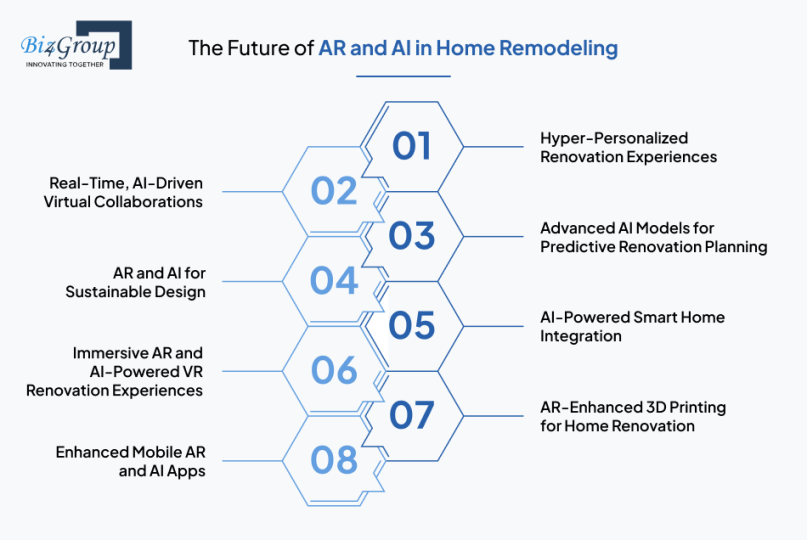
While AR and AI are already transforming the way we approach home renovation, this is just the beginning. The next few years are poised to bring even more exciting developments, pushing the boundaries of what’s possible in the industry.
Here are some key future trends that will continue to shape AR and AI in home renovation:
AR and AI will evolve to create even more personalized experiences.
AI will learn from client preferences and make increasingly accurate suggestions, while AR will allow users to make modifications in real-time, seamlessly blending personalization with their existing space.
Why It Matters:
Clients will have a home renovation experience that feels entirely tailored to their tastes, creating higher satisfaction and deeper emotional engagement with their space.
The integration of AI-driven virtual assistants will allow clients, designers, and renovation teams to collaborate in real-time on a shared AR platform, the type of solutions pioneered by specialized AI agent development company teams.
Why It Matters:
This will dramatically reduce project timelines and improve decision-making speed, as teams can easily make adjustments and communicate instantly.
AI models will become more sophisticated, offering predictive analytics for renovation projects. These models will forecast costs, materials, and even design success, based on historical data and user preferences, the same predictive power now driving AI in real estate investment.
Why It Matters:
Companies can plan renovations more efficiently, with fewer errors and delays, while clients will have a clearer understanding of project timelines and costs before the first tool is lifted.
Both AR and AI will play a crucial role in promoting sustainable design by helping designers visualize eco-friendly materials and optimizing energy-efficient solutions, innovations increasingly powered by leading generative AI development company solutions.
Why It Matters:
As environmental sustainability becomes a growing concern, integrating these technologies will allow companies to offer greener, more energy-efficient renovation options, appealing to eco-conscious clients.
As smart homes become more common, AR and AI will be used to design and plan home renovations that integrate seamlessly with smart technology (e.g., lighting, heating, security).
Why It Matters:
AI will optimize these systems for efficiency, while AR will help clients visualize how these smart devices will integrate into their home design before installation. This will give clients more control over their smart homes, making them more functional and user-friendly.
Combining virtual reality (VR) with AR and AI will enable fully immersive renovation simulations, where clients can experience their new home before any work begins, down to the smallest detail.
Why It Matters:
This level of immersion will allow for more accurate decision-making, as clients can "live" in the space before committing to changes. It’s also a great way to showcase the finished product, reducing hesitation and driving sales.
AR and AI will integrate with 3D printing technologies, allowing designers to create customized home features, furniture, and décor with precise measurements and specifications.
Why It Matters:
Clients will have unique, on-demand designs created with AR and 3D printing, turning customization into reality without the hefty cost of traditional manufacturing.
For broader industry context, here’s a guide on how to implement generative AI in real estate, where similar AI-driven customization is reshaping the market.
As mobile devices become more powerful, AR and AI apps will improve in both functionality and accessibility. Expect apps that can handle more complex tasks, such as real-time cost calculations, instant design previews, and smart product suggestions, directly from a mobile phone or tablet, similar to what’s outlined in this real estate mobile app development guide.
Why It Matters:
Clients and businesses will have greater flexibility and control, enabling them to access AR and AI tools on-the-go and manage renovation projects from anywhere.
The future of AR and AI in home renovation is bright, and the possibilities are nearly limitless. By embracing these trends, businesses can position themselves as leaders in a rapidly evolving market, delivering more value to clients while improving their own operational efficiency.
And guess who you should partner with for such limitless possibilities?
Building high tech needs trust, and at Biz4Group, we are trusted advisors to businesses looking to integrate cutting-edge technologies like Augmented Reality (AR) and Artificial Intelligence (AI) into their operations.
We’re more than just a real estate AI software development company. We’re innovators, problem-solvers, and collaborators, working side by side with our clients to turn their ideas into reality.
We believe in providing smart, efficient, and productive solutions, with a strong focus on user experience and measurable results.
With years of experience under our belt, we specialize in crafting personalized tech solutions that empower businesses, particularly in the real estate and home renovation industries.
Our team works tirelessly to create intelligent applications that are not only functional but also scalable and future-proof.
When you partner with Biz4Group, you get a partner who is committed to understanding your challenges, helping you grow, and guiding you every step of the way as you embrace the latest in tech innovations.
Our goal is simple: to make your business smarter, more efficient, and ready to succeed in a technology-driven world.
Businesses choose Biz4Group because we provide more than just a software development company. We provide solutions that enhance efficiency, drive growth, and improve customer satisfaction.
Here’s why companies partner with us:
With a proven track record in developing innovative AI, AR, and cloud-based solutions, we bring industry-leading knowledge to every project.
We tailor our solutions to meet your specific needs, ensuring that our technology enhances your unique processes, not complicates them.
From initial consultation and strategy to development and deployment, we offer comprehensive support at every stage of your project.
As trusted advisors, we prioritize your goals and work closely with you to ensure the solution fits your business perfectly.
Our solutions are designed to improve productivity, reduce costs, and create real value for your business.
We’re proud of the transformative work we’ve done in the real estate sector. Here are some of our standout projects:
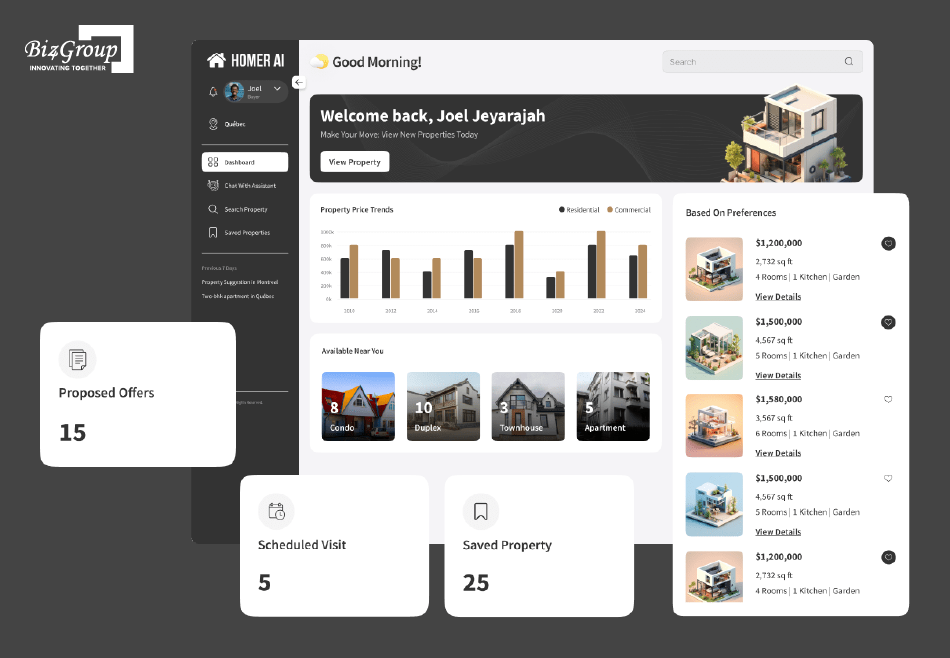
Homer AI is an innovative AI-based platform designed to bridge the gap between buyers and sellers in the real estate market. Our team at Biz4Group developed this smart platform to provide end-to-end property management. From understanding buyer preferences to scheduling property visits, Homer AI ensures a seamless experience for all parties.
Key Features:
Homer AI has transformed property transactions by automating tedious processes and improving communication.
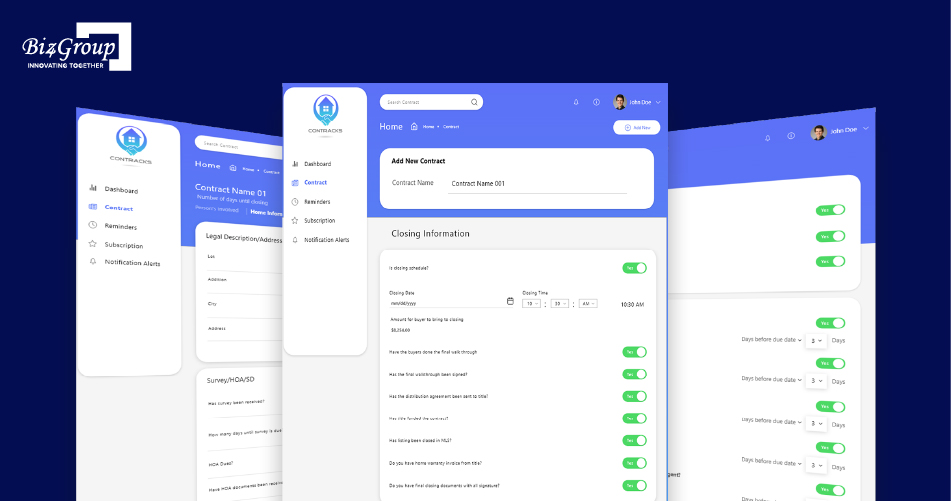
Contracks is a real estate contract management tool that we developed to automate and streamline contract workflows. With integrated AI features for document summarization and contract tracking, this platform reduces the time and effort spent on paperwork, ensuring that agents and brokers stay ahead.
Key Features:
With Contracks, real estate professionals can spend less time on administrative tasks and more time focusing on closing deals, ultimately increasing productivity and efficiency.
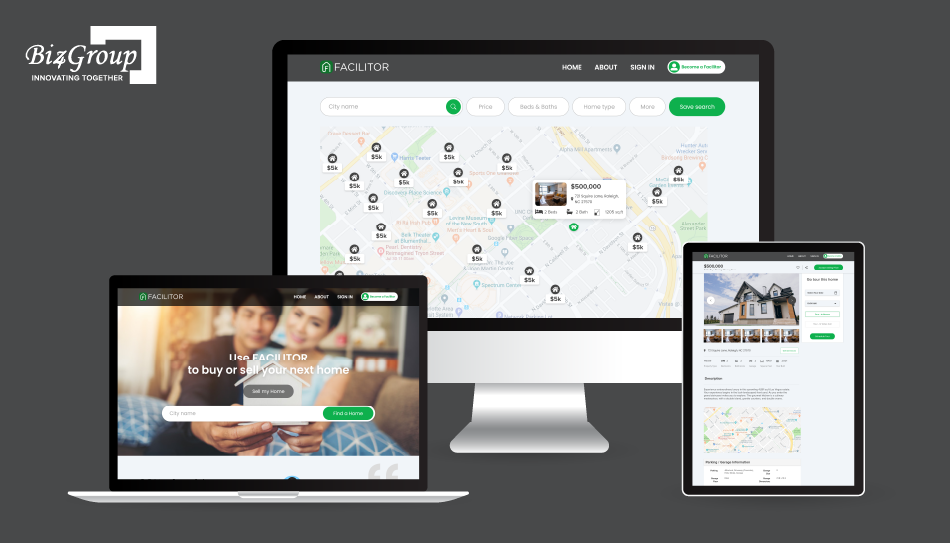
Facilitor is an AI-powered real estate platform designed to facilitate communication between buyers and sellers, while also addressing the challenges of remote property visits. Our solution provides a safe, seamless experience with AI-powered property recommendations and realtor-facilitated visits for properties in remote locations.
Key Features:
By offering a unique combination of AI and realtor support, Facilitor enhances safety, reduces property visit friction, and streamlines the buying process for remote properties.

Renters Book is a review and ratings platform for rental agreements that we developed to help tenants and landlords make informed decisions based on verified feedback. By allowing users to post and view reviews, the platform fosters trust and transparency in rental transactions.
Key Features:
Renters Book promotes trust and transparency in the rental market, helping tenants and landlords find the best match for their needs while avoiding unpleasant surprises.
Partnering with Biz4Group means stepping into the future with the guidance of trusted advisors who understand the challenges and opportunities in today’s digital world. From AI-powered real estate platforms to AR-enhanced design tools, we provide tailored solutions that deliver real value and business growth.
If you’re ready to innovate, streamline, and elevate your business, we’re here to help you get started. Let’s connect today and start building the future of home renovation and real estate, together.
The world of home renovation is evolving faster than ever before. Augmented Reality and Artificial Intelligence are no longer futuristic concepts. They’re here, transforming the way we design, plan, and execute renovations.
These technologies offer endless possibilities: from visualizing your dream space in real-time to making smarter design decisions based on data, AR and AI are reshaping every step of the process.
As these innovations continue to push boundaries, one thing is clear, businesses that adopt and integrate these technologies will thrive. Not only will they enhance client engagement, but they’ll also streamline workflows, cut down on costs, and boost overall productivity. The companies that embrace AR and AI today will be the leaders of tomorrow’s home renovation industry.
At Biz4Group, we don’t just help you keep up with the trends, we also help you lead the charge. With our expertise in developing cutting-edge AR and AI solutions, we’re here to help you stay ahead of the curve, ensuring your business is future-proofed and ready to tackle the evolving challenges of the renovation industry.
Whether you’re looking to build smart renovation apps or scale enterprise platforms, you can hire AI developers from our expert team to bring your vision to life.
And now it’s time to transform your business with the power of AR and AI. Let’s connect and start building the future of home renovation together, one innovative solution at a time.
Augmented reality (AR) enhances the home renovation process by allowing homeowners and designers to visualize changes in real-time. This technology helps you experiment with colors, furniture, layouts, and even structural changes before committing, saving time and reducing costly mistakes.
Artificial intelligence (AI) can predict renovation costs accurately by analyzing data from past projects, materials, labor, and more. It helps homeowners and contractors stay within budget by providing cost estimates and suggesting cost-effective alternatives based on data-driven insights.
Yes! AR and AI can optimize designs for sustainability by suggesting eco-friendly materials, energy-efficient layouts, and resource-saving techniques. AR helps visualize how these sustainable changes will look, while AI calculates the environmental impact and helps create the most eco-friendly solutions for a space.
AR significantly boosts client engagement by offering interactive design experiences. Clients can visualize and modify designs in real-time, explore different options, and make informed decisions. This immersive experience builds excitement, reduces hesitation, and helps clients feel more confident in their renovation choices.
AR and AI enable home renovation businesses to scale by automating repetitive tasks, improving project efficiency, and providing personalized design recommendations. With these technologies, companies can handle larger volumes of work, offer more services, and deliver customized solutions without increasing overhead or compromising quality.
with Biz4Group today!
Our website require some cookies to function properly. Read our privacy policy to know more.